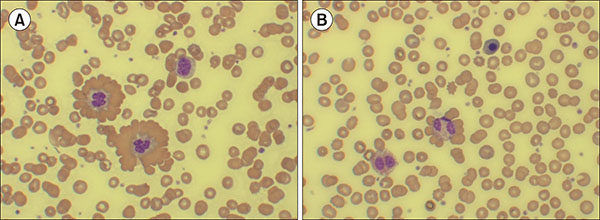
An 83-year-old woman was transferred for antifungal therapy for candidemia that occurred during an intracerebral hemorrhage treatment at another hospital. At admission, complete blood count results were as follows: hemoglobin, 8.8 g/dL; white blood cell (WBC), 18.51×109/L; neutrophil, 16.66×109/L; platelet, 52×109/L; and elevated C-reactive protein (CRP) and procalcitonin, 32.47 mg/dL and 6.60 ng/mL, respectively. After anidulafungin treatment, WBC count and CRP level were normalized, but hemoglobin level continued to decrease. Test results for anemia were as follows: ferritin, 741.82 ng/mL; iron, 198 µg/dL; transferrin saturation, 87.6%; total iron-binding capacity, 226 µg/dL; folate, 6.4 ng/mL; vitamin B12, >2,000 pg/mL; lactate dehydrogenase, 538 U/L; total bilirubin, 4.99 mg/dL; collected reticulocyte count, 3.4%; and haptoglobin, 24 mg/dL. The direct antiglobulin test for IgG+ C3d was negative; hematuria was not observed. Considering these findings, autoimmune hemolytic anemia (AIHA) was suspected, and peripheral blood (PB) smear conclusively showed frequent neutrophil-erythrocyte rosettes [composite image of PB smear, Wright-Giemsa staining, ×400; (A) red blood cell (RBC) rosettes around neutrophils. (B) Few nucleated RBC were observed, but schistocyte or spherocytes were not observed]. The neutrophil-erythrocyte rosettes formation is a very rare AIHA phenomenon. This phenomenon is caused by the interaction between neutrophil Fc receptors and IgG-decorated RBCs.




 PDF
PDF ePub
ePub Citation
Citation Print
Print


 XML Download
XML Download